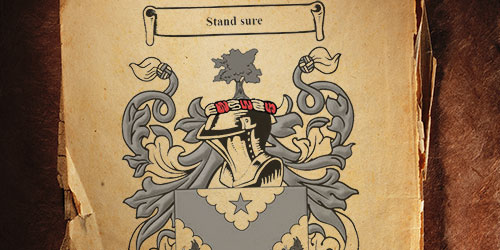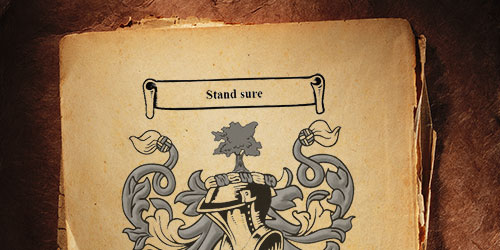What is a Coat of Arms? A guide to the Key Elements (Family Crest Explained too)
A coat of arms is a striking emblem that tells the story of a family name. From the shield to the crest, each part has a meaning rooted in history. While initially used for identification in battle, today a coat of arms is a beautiful way to honour and celebrate your surname's history.
Below, we'll explore the key elements of a coat of arms:
.jpg)
Example of a Coat of Arms
1. The Shield ("Arms"):
The shield is the heart of the coat of arms. Historically, they were simply painted with one or more bands of heraldic colours (tinctures). As time passed, the shield grew to include more divisions (ordinaries) and icons (charges) to be uniquely distinct. A shield will reflect family history, achievements, and core values.

Example of a shield on a Coat of Arms
2. The Helmet ("Helm", "Casque", or "Morion"):
The helmet sits above the shield. They varied in shape and style to reflect rank, status, or even country of origin. The Esquire Helm, as depicted in family arms, is always with a closed visor and facing to the left.

Example of a helm on a Coat of Arms
3. The Crest:
Perched atop the helmet is the crest, which was usually made of wood, metal, or boiled leather and often displayed a three-dimensional figure (animal, object, or mythical creature). It provided the double advantage of easy identification and added height to the wearer. In heraldry today, the crest and the shield are usually displayed together.

Example of a crest on a Coat of Arms
4. The Torse ("Wreath"):
The torse, also known as a wreath, is a twisted band of cloth that sits between the helmet and crest. Historically, this piece was twisted together by the lady who chose the bearer for her knight and was used to hold the crest and mantling in place on the helm. The tinctures of the torse are always those of the principal metal and color of the arms, with the exception being in continental heraldry.

Example of a torse on a Coat of Arms
5. Mantling ("Lambrequin"):
Flowing out from the helmet is the mantling. It served as the knight's protection, "to repel the extremities of wet, cold, and heat, and to preserve the armor from rust". The numerous cuts and slits indicated bravery and resilience on the battlefield.

Example of a mantle on a Coat of Arms
6. Motto:
A motto is a short phrase, usually displayed on a scroll, that expresses the family's guiding principles and war cry. Mottos can also contain an allusion to a memorable event in the family history; e.g., the "Bruce" motto 'Fuimus' (Latin-'We were') refers to the fact that the family were once the kings of Scotland.

Example of a motto on a Coat of Arms
Common Questions About Coat of Arms
Q: What's the difference between a coat of arms and a family crest?A: A Family Crest is technically only one component of a full coat of arms. However, we've noticed that some people refer to coat of arms as "family crests" in their region, which is why you'll see both terms across the website.
Q: Why is the torse twisted?
A: It's to hide the joint between the helmet and the crest.
Q: Do the colours have meaning?
A: Yes! Each colour ("tinctures") is based on heraldic and carries a symbolic meaning. For example, gold represents generosity, and red signifies courage.
Q: Do all coats of arms include supporters?
A: Nope, supporters are optional heraldic elements, and for our designs, we focus on the shield, crest, torse, mantling, and motto.
References
- ^ Swyrich, Archive materials
- Fox-Davies, Arthur Charles. A Complete Guide to Heraldry. Doge Publishing Co., 1909
- "Parts of a Coat of Arms." The Governor General of Canada, Canadian Heraldic Authority, gg.ca